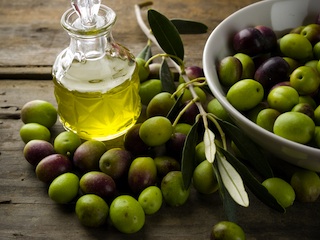Olive Oil for Skin

Extra virgin olive oil is the perfect addition to that Greek salad or boconccini tomato salad ... but it's also a perfect addition to your skin care products.
For literally thousands of years, the ancient people around the Mediterranean have been using olive oil for skin care:
- to smooth the skin
- to exfoliate and cleanse it
- to moisturize it
- to help it heal
- to help it regain elasticity
Olive oil has been used for skin care perhaps most widely than any other product: on scar marks, on stretch marks, on face skin, on hands, on feet, on body skin, as well as for hair and scalp treatment, for nails and cuticles, etc.
Best time to treat your skin? In talking to estheticians , most suggest,
for at home use, an overnight application for maximum benefit. On the
face, apply to thoroughly cleaned and dried skin. Using fingertips,
gently massage small amounts of slightly warmed olive oil over face and
neck and ears. However, only use as much as your skin can completely
absorb. Excess should be removed by using a damp warm washcloth, gently
and by using circular motions, removing the excess oil.
For all over body use, add olive oil to your bath water and soak. When
you get up, do not dry off immediately. Oil, generally, forms a layer on
top of the water. As you get up, this layer clings to your skin. Gently
massage it into your skin and then remove any excess oil by using a dry
but warm towel.
And, last but not least, everybody
wants to have beautiful looking feet. Depending on the part of the world
one lives in, they are either hidden for long periods of time by
stocking or socks, shoes (regular or exercise) and, for those
experiencing winter climates, boots. On the other end of the spectrum
are individuals living in ‘clement’ climates and wearing sandals for
most of the time. In either case, if the skin of ones feet is not being
nourished, it gives and dry and cracked appearance.
Again, before retiring for the night, massage warmed olive oil
generously all over your feet, giving special attention to the heels and
toes, as well as between the toes. This time, do not remove excess oil
but wear a pair of (old) socks, preferably cotton, overnight.
How often one uses olive oil in skin treatments depends on its dryness;
yet, the benefits will become apparent very quickly. But remember, only
use the purest oil you can find. The quantity used in each application
does not need to be large; a small amount goes a long way.
In summary, not only olive oil can be a great addition for skin care, but it can also replace a multitude of cosmetics, which for the most part are expensive, don't always work as advertised and, unlike the totally natural olive oil, are often full of chemicals.
So, next time you think of olive olive as a fantastic ingredient for your salads, also think of the wonders it can make for your skin. :-)

Why is olive oil so good and yet so healthy at the same time?
We're used to having to choose between the two. For example, when we're presented with food that tastes like cardboard but we're told is full of organic, unsweetened fiber. ;-)
Well, olive oil is mostly composed of mono unsaturated
fatty acids. These acids can help lower the risk of heart disease by lowering cholesterol levels. They can
also help normalize blood clotting and be beneficial to blood sugar control (re: diabetes). Olive oil is rich as well in antioxidants and in vitamin E, which are believed to play a role in cancer prevention.
So, enjoy olive oil in its many uses, mainly culinary ... and remember that the secret is to add olive oil to other quality ingredients (e.g. tomatoes, feta, arugula, bocconcini, etc) to end up with absolutely delicious and healthy food!



New! Comments
Have your say about what you just read! Leave me a comment in the box below.